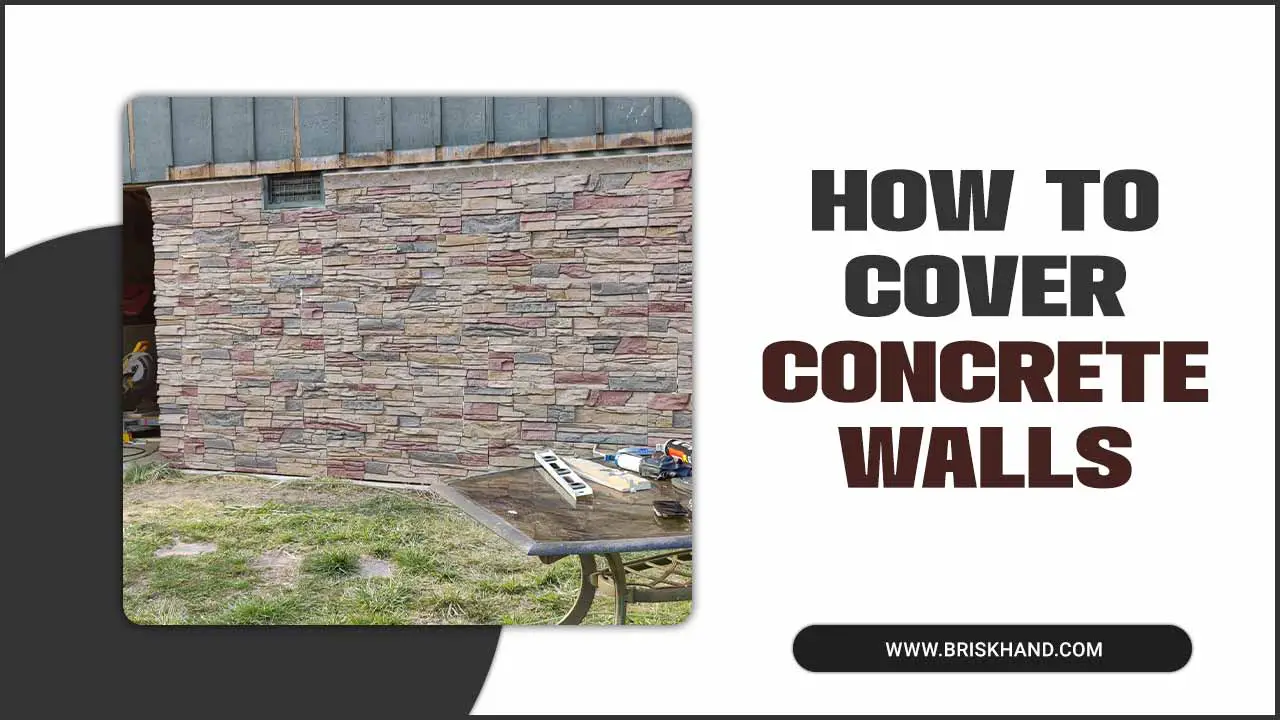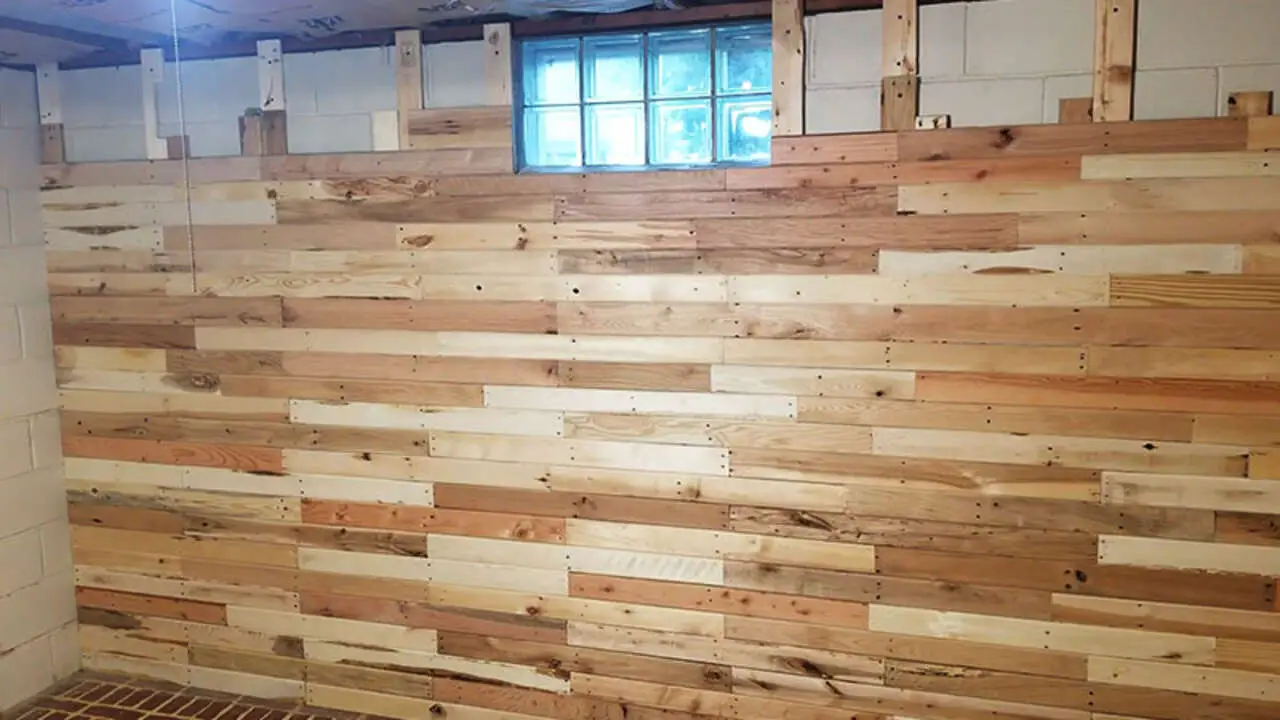Covering concrete walls is essential for various reasons. It protects them from moisture damage and mold growth and reduces cracking.
Additionally, covering concrete walls enhances the aesthetics of your space, improves insulation, and increases the resale value of your property. Here we’ll walk you through everything you need to know about how to cover concrete walls. We’ll explain why covering them is a good idea and what tools and materials you need.
Then we’ll dive into six methods for covering concrete walls: drywall, fabrics, wallpaper, stone veneer, fiberboard wood paneling, and painting or staining. We’ll also discuss common mistakes to avoid and how to maintain your newly covered walls once they’re complete.

Necessary Tools And Materials

When it comes to covering concrete walls, having the right tools and materials is essential for a successful project. With these tools and materials, you can confidently tackle your concrete wall covering project and achieve the desired results. Here is a list of necessary items you will need:
- Paint Or Primer: Depending on the desired finish, you may need paint or primer specifically formulated for concrete surfaces.
- Masonry Adhesive: This adhesive attaches decorative elements or coverings to the wall.
- Stucco Or Mortar Mix: Stucco or mortar mix will be necessary if you want a textured or plaster-like finish.
- Trowel: A trowel is used to apply and spread the stucco or mortar mix onto the wall.
- Wire Brush: A wire brush is handy for cleaning and preparing the concrete surface before applying any coverings.
- Level and measuring tape: These tools will help ensure your coverings are installed evenly and accurately.
- Drop Cloths Or Plastic Sheeting: To protect surrounding areas from any mess or debris during installation.
- Safety Equipment: Gloves, safety goggles, and a dust mask should be worn when working with concrete and other materials to protect yourself.
How To Cover Concrete Walls In 6 Methods

Covering concrete walls can be a great way to transform the look and feel of a space. You can use several methods to cover concrete walls, depending on your preferences and budget. Before starting any project to cover your concrete walls, properly clean and prepare the surface to ensure proper adhesion and longevity of the chosen method.
Additionally, it may be helpful to consult with a professional contractor or designer for guidance on which method will work best for your specific situation. Here are six popular methods on how to cover concrete walls:
Method 1: Employing Drywall For Covering Concrete Walls

To cover concrete walls using drywall, install furring strips to create a gap between the concrete wall and the drywall. This helps in preventing moisture buildup and allows for proper insulation. Once the furring strips are in place, attach the drywall panels to them using screws.
Make sure to secure the drywall firmly to the strips. Afterward, apply a joint compound to fill gaps or seams and sand the surface for a smooth finish. Finally, you can either paint the drywall or apply wallpaper further to customize the look and feel of the space.
Method 2: Using Fabrics To Change The Look Of Concrete Walls
An alternative method is to utilize fabrics to transform the look of concrete walls. Hang curtains or tapestries that complement the overall design and style of the space. Securely hang the fabrics using curtain rods or hooks. For added visual interest, consider layering different fabrics or patterns.
This DIY approach offers a versatile and cost-effective solution for covering concrete walls. Fabrics can be chosen based on personal preference, allowing for customization and flexibility. By incorporating fabrics, you can soften the appearance of concrete walls and create a cozy and inviting atmosphere in any room.
Method 3: Enhancing Aesthetics With Wall Vinyl And Wallpaper
When it comes to enhancing the aesthetics of concrete walls, one effective method is to use wall vinyl and wallpaper. To begin, measure and cut the wall vinyl or wallpaper to fit the dimensions of the concrete walls. Next, you can choose to apply adhesive or opt for peel-and-stick options for easier installation.
Once in place, smooth out any air bubbles or wrinkles to achieve a seamless appearance. Finally, select patterns or designs that align with your personal taste and style. This DIY approach lets you transform your concrete walls into visually appealing focal points without extensive masonry work or plastering.
Method 4: Transforming Concrete Walls With Stone Veneer

Transforming concrete walls with stone veneer is a popular DIY method that can give your space a masonry look. First, prepare the concrete walls by cleaning them thoroughly and applying a bonding agent. Next, mix and apply mortar to the back of the stone veneer sheets.
Press the sheets onto the prepared walls and use a trowel to smooth out the mortar for proper adhesion. Allow the stone veneer to dry and cure before sealing or finishing. This method is a good way to cover concrete walls and achieve a realistic stone appearance.
Method 5: Introducing A Rustic Touch With Fiberboard Wood Paneling
To achieve a rustic touch with fiberboard wood paneling, start by measuring and cutting the panels to fit the dimensions of the concrete walls. Secure the panels using adhesive or nails, ensuring a strong bond to the surface.
Fill any gaps or seams with wood filler before sanding the surface for a smooth finish. Stain or paint the wood paneling in your desired style to complete the rustic look. This method adds warmth and texture to your space, creating a cozy and inviting atmosphere. Enjoy the charm of wood while covering your concrete walls.
Method 6: Painting Or Staining Concrete Walls For A Fresh Look
To give your concrete walls a fresh look, start by preparing the surface. Clean the walls thoroughly and fill any cracks or holes using a suitable filler. Next, choose a paint or stain specifically designed for concrete surfaces. Following the manufacturer’s instructions, DIY enthusiasts can use a brush, roller, or sprayer to apply the paint or stain.
For better coverage and durability, consider applying multiple coats. Finally, add a protective sealant to safeguard the walls against weather and moisture. Painting or staining concrete walls is a good way to transform their appearance and enhance the overall aesthetics of your space.
Some Common Mistakes To Avoid While Covering Concrete Walls?

When covering concrete walls, there are some common mistakes that you’ll want to avoid. By avoiding these common mistakes, you can ensure a successful and long-lasting cover for your concrete walls. Here are some common mistakes:
- One of the biggest mistakes is not properly preparing the surface before applying any type of covering. It’s important to thoroughly clean the wall and remove any loose debris or dirt. Additionally, if there are any cracks or imperfections in the concrete, these should be repaired before applying a covering.
- Another mistake to avoid is using the wrong material for the job. Some materials may not adhere to concrete or provide enough coverage. It’s important to choose a material that is specifically designed for covering concrete walls.
- Lastly, follow the manufacturer’s instructions when applying the covering. Improper application can result in a less-than-desirable finish or even cause damage to the wall itself.
How To Maintain Your Newly Covered Concrete Walls?
After covering your concrete walls, it is important to maintain them to ensure their longevity and appearance properly. By following these tips and properly maintaining your newly covered concrete walls, you can ensure that they remain in good condition and continue to enhance the aesthetic appeal of your space for years to come. Here are some tips for maintaining your newly covered concrete walls:
- Regular Cleaning: Regularly clean your concrete walls to remove dirt, dust, and other debris that can accumulate over time. Use a mild detergent, water solution, and a soft brush or cloth to scrub the surface gently. Avoid harsh chemicals or abrasive cleaners, as they can damage the covering material.
- Inspect For Damage: Periodically inspect your concrete walls for any signs of damage, such as cracks or peeling of the covering material. If you notice any issues, address them promptly to prevent further deterioration.
- Protect From Moisture: Concrete walls can be prone to moisture damage, so it’s important to protect them. Ensure that gutters and downspouts are functioning properly to direct water away from the walls. Consider applying a waterproofing sealant or coating to provide an additional layer of protection.
- Avoid impact or abrasion: Avoid hitting or scraping your concrete walls with sharp objects or heavy equipment, as this can cause damage to both the covering material and the underlying concrete.
Conclusion
There are several methods available to cover concrete walls and transform their appearance. In the above guide, we have explored how to cover concrete walls. Whether you use drywall, fabrics, wall vinyl, stone veneer, fiberboard wood paneling, or paint, each method offers unique benefits and aesthetic appeal.
However, it is important to properly prepare the concrete walls and use the necessary tools and materials for a successful transformation. Additionally, be mindful of common mistakes to avoid during the process and ensure proper maintenance of your newly covered walls to prolong their lifespan. With these tips in mind, you can easily give your concrete walls a fresh and stylish look that enhances the overall aesthetic of your space.
Frequently Asked Questions
1.What Are The Advantages Of Covering A Concrete Wall?
Ans: Covering a concrete wall offers several benefits. It enhances the aesthetics of a space while providing insulation and increasing energy efficiency. Additionally, it protects the wall from weather damage and wear and tear. By creating an updated look, covering a concrete wall can also add value to the property.
2.What Are The Disadvantages Of Leaving A Concrete Wall Exposed?
Ans: Leaving a concrete wall exposed can create an unattractive and visually unappealing space. Additionally, the porous nature of concrete allows it to absorb moisture, leading to potential mold or mildew growth. Uninsulated concrete walls can also increase energy bills due to heat loss or gain. Lastly, leaving a concrete wall exposed may limit your options for decorating or furnishing the space.
3.How Much Does It Cost To Cover A Concrete Wall, And What Factors Affect The Price?
Ans: Covering a concrete wall can vary in cost due to size, materials, and labor. Stucco, stone veneer, and wood paneling are common options. Prices typically range from $5 to $20 per square foot. Factors influencing cost include material quality, design complexity, and project location.
4.Are There Any Environmental Considerations To Keep In Mind When Covering A Concrete Wall?
Ans: When covering a concrete wall, it’s important to consider the environment. Use eco-friendly materials and opt for recycled or upcycled options. Consult with professionals to ensure your covering method doesn’t harm the environment or create hazards.
5.Do I Need To Fill Cinder Blocks With Concrete?
Ans: While not always necessary, filling cinder blocks with concrete can provide stability and insulation. If the blocks will be exposed to water or freeze-thaw cycles, it’s recommended to fill them. Consult a professional for guidance.

I am passionate about tools and electric work. I love finding new tools and experimenting with them.

